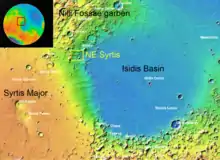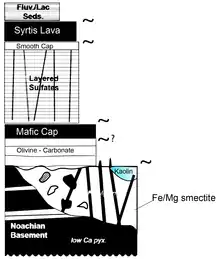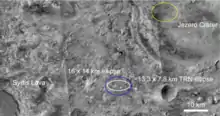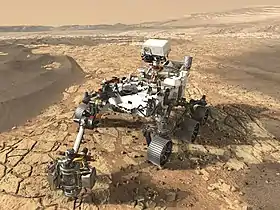Northeast Syrtis
Northeast Syrtis is a region of Mars once considered by NASA as a landing site for the Mars 2020 rover mission.[1] This landing site failed in the competition with Jezero crater, another landing site dozens of kilometers away from Northeast Syrtis.[2] It is located in the northern hemisphere of Mars at coordinates 18°N,77°E in the northeastern part of the Syrtis Major volcanic province, within the ring structure of Isidis impact basin as well. This region contains diverse morphological features and minerals, indicating that water once flowed here.[3][4][5][6][7][8] It may be an ancient habitable environment; microbes could have developed and thrived here.

The layered terrain of Northeast Syrtis is unique on the surface of Mars, containing diverse aqueous minerals such as like clay, carbonate, serpentine and sulfate,[6][9] as well as igneous minerals such as olivine and high-calcium and low-calcium pyroxene. Clay minerals form in the interaction between water and rock[10] and sulfate minerals usually form through intense evaporation on Earth. Similar processes may happen on Mars forming these minerals, which strongly suggests a history of water and rock interaction. In addition, megabreccia, possibly the oldest material throughout this region (some blocks are over 100 m in diameter), could give an insight into the primary crust when Mars first formed.[5] The location is an ideal site for studying the timing and evolution of the surface processes of Mars, such as huge impact basin formation, fluvial activity (valley networks, small outflow channels), groundwater activity, history of glaciation, and volcanic activity.[3]
Regional stratigraphy

The regional stratigraphy of Northeast Syrtis has been studied in detail.[3][7] This area is sandwiched between a huge shield volcano—Syrtis Major—and one of largest impact basins in the solar system, and therefore could provide a key constraint of the timing of key events in the history of Mars. The stratigraphy can be divided into four major units, from young to old:[12]
- Syrtis Major lavas unit contains high-calcium pyroxene bearing material;
- Layered sulfate-bearing unit, include poly-hydrated sulfates and jarosite;
- Olivine unit, olivine-enriched unit variably altered to carbonate and serpentine;
- Basement unit: The mixture of iron/magnesium (Fe/Mg) smectite and low-calcium pyroxene-bearing unit variably altered to Aluminium-clay bearing materials.[12]
The basement unit is one of newest units on Mars, recording early-stage evolution history of terrestrial planets. The change from carbonate to sulfate indicates a transition from alkaline-neutral to acid aqueous environments.[3]
Mars 2020 mission
The Mars 2020 rover launched in July 2020 with Atlas V rocket to reach Mars in February 2021. This rover inherits from the Mars Science Laboratory Curiosity, with similar entry, descent, and landing systems, and the sky crane. Besides exploring a likely habitable site and searching for signs of past life, collecting scientifically compelling samples (rock and regolith) which could address fundamental scientific questions if returned to Earth, is the main goal of the Mars 2020 mission.[13] The landing site's selection is the key part of this mission's success.[14]
Although Northeast Syrtis survived the cut in third Mars 2020 Landing Site Workshops, it failed final completion. The landing ellipse of Northeast Syrtis is 16 x 14 km and the smaller ellipse is 13.3 × 7.8 km with the help of advanced technologyTerrain-Relative Navigation (TRN).[2][15]

Region of interest

Mesa unit

The mesa is one of the interesting locations. It consists of five subunits: crater-retaining cap, boulder-shedding slopes exposing lightened blocks, olivine-carbonate unit, Fe/Mg-phyllosilicate, allowing easy to access diverse rocks.[16][17]
On the top of the mesa is a dark toned cap unit, composed of meter-scale boulders. It was interpreted as Hesperian Syrtis Major lava flows or lithified ash. These igneous rocks are suitable samples for acquiring the age of Martian geologic events, which could calibrate the planet dating method. Unlike Earth, planet dating mainly relies on crater counting, a method based on the assumption that the number of impact craters on a planet surface increases with the length of time that the surface has been exposed to space cratering, calibrated using the ages obtained by radiometric dating of samples of Luna and Apollo missions. The samples of this mission returned to Earth will be analyzed by state of the art equipment in laboratories. Igneous samples from Northeast Syrtis could provide four key time for Martian geology history, including (1) the timing of Isidis impact event, (2) the timing of emplacement of olivine-rich unit, (3) the timing of dark-toned mafic cap rock, (4) the timing of Syrtis lava flows, which would fundamentally improve human knowledge of early Mars and the early history of solar system, such as the late-heavy bombardment.[16][17]
This region exposes the largest high-olivine abundance rocks on Mars.[18] The origin of high-olivine rock is still in debate. Impact cumulates[5] or olivine-rich lava[19][20] are two leading hypotheses. A portion of olivine rock was altered to carbonate. Many hypotheses have been proposed to explain the origin of carbonate, including a serpentine springs system.[21][22] Carbonate is important sink of carbon, and is a crucial part of understanding the carbon cycle of Mars. Future sample return could shed light on the environmental conditions of carbonate. As well, the isotopic composition of carbonate through time, records the atmosphere loss, and it also reveals whether life once emerged on Mars.[16][17]
The lower part of mesa unit is the basement unit of the Northeast Syrtis region, consisting of Fe/Mg smectites and low calcium pyroxene. The basement unit was partially altered to form kaolinite. The kaolinite (Al-clay) usually overlying the Fe/Mg smectites across the Martian surface.[16] Weathering in a warm climate or acid leaching are two domain interpretations of kaolinite formation.[16][17]
Megabreccia

Megabreccia occurs throughout the basement unit of Northeast Syrtis. The composition of these megabreccias is complex, including altered or mafic material.[5] These megabreccias may be uplifted and exposed by the Isidis Basin forming event. The megabreccia could reveal the nature of the remnant of Mars's primary crust or the Noachian-aged low-calcium pyroxene lavas. It also could constrain the timing of Martian dynamo activity.
Layer sulfate unit
Further to the south of the landing ellipse, there is a 500-metre (1,600 ft) thick sequence of sulfate deposits capped by lava flows from the later Syrtis Major volcanic formation. The layer of sulfates include poly-hydrated sulphates and jarosite. Jarosite usually indicate oxidizing and acid (pH<4) environments. The occurrence of jarosite indicates that the environment changed from neutral/alkaline (as suggested by extensive Fe/Mg smectites and carbonate) to acid.[3] The detection of sulfate adds more complexity to Martian geologic history.
See also
References
- "Mars 2020 Rover". NASA. Retrieved 9 October 2018.
- Hautaluoma, Grey (19 November 2018). "NASA Announces Landing Site for Mars 2020 Rover". NASA. Retrieved 2018-11-20.
- Ehlmann, Bethany L.; Mustard, John F. (June 2012). "An in-situ record of major environmental transitions on early Mars at Northeast Syrtis Major". Geophysical Research Letters. 39 (11): n/a. doi:10.1029/2012GL051594.
- Mangold, N.; Ansan, V.; Baratoux, D.; Costard, F.; Dupeyrat, L.; Hiesinger, H.; Masson, Ph.; Neukum, G.; Pinet, P. (May 2008). "Identification of a new outflow channel on Mars in Syrtis Major Planum using HRSC/MEx data". Planetary and Space Science. 56 (7): 1030–1042. doi:10.1016/j.pss.2008.01.011. ISSN 0032-0633.
- Mustard, J. F.; Ehlmann, B. L.; Murchie, S. L.; Poulet, F.; Mangold, N.; Head, J. W.; Bibring, J.-P.; Roach, L. H. (12 December 2009). "Composition, Morphology, and Stratigraphy of Noachian Crust around the Isidis basin". Journal of Geophysical Research. 114. doi:10.1029/2009JE003349. S2CID 17913229.
- Ehlmann, Bethany L.; Mustard, John F.; Swayze, Gregg A.; Clark, Roger N.; Bishop, Janice L.; Poulet, Francois; Des Marais, David J.; Roach, Leah H.; Milliken, Ralph E.; Wray, James J.; Barnouin-Jha, Olivier; Murchie, Scott L. (23 October 2009). "Identification of hydrated silicate minerals on Mars using MRO-CRISM: Geologic context near Nili Fossae and implications for aqueous alteration" (PDF). Journal of Geophysical Research. 114. doi:10.1029/2009JE003339.
- Bramble, Michael S.; Mustard, John F.; Salvatore, Mark R. (September 2017). "The geological history of Northeast Syrtis Major, Mars". Icarus. 293: 66–93. doi:10.1016/j.icarus.2017.03.030. ISSN 0019-1035.
- Ehlmann, Bethany L.; Mustard, John F. (June 2012). "An in-situ record of major environmental transitions on early Mars at Northeast Syrtis Major". Geophysical Research Letters. 39 (11): n/a. CiteSeerX 10.1.1.656.7596. doi:10.1029/2012gl051594. ISSN 0094-8276.
- Murchie, Scott L.; Mustard, John F.; Ehlmann, Bethany L.; Milliken, Ralph E.; Bishop, Janice L.; McKeown, Nancy K.; Noe Dobrea, Eldar Z.; Seelos, Frank P.; Buczkowski, Debra L. (22 September 2009). "A synthesis of Martian aqueous mineralogy after 1 Mars year of observations from the Mars Reconnaissance Orbiter" (PDF). Journal of Geophysical Research. 114 (E2). doi:10.1029/2009je003342. ISSN 0148-0227.
- Poulet, F.; Bibring, J.-P.; Mustard, J. F.; Gendrin, A.; Mangold, N.; Langevin, Y.; Arvidson, R. E.; Gondet, B.; Gomez, C. (December 2005). "Phyllosilicates on Mars and implications for early martian climate". Nature. 438 (7068): 623–627. doi:10.1038/nature04274. ISSN 0028-0836. PMID 16319882. S2CID 7465822.
- Bethany, Ehlmann. "Mapping the Decadal Survey Drivers for Sample Return to Geologic Units Accessible in the Primary and Extended Missions from NE Syrtis and Midway" (PDF). Fourth landing site workshop for the Mars 2020 rover mission.
- Quantin-Nataf, C.; Dromart, G.; Mandon, L. (2018). "NOACHIAN TO AMAZONIAN VOLCANIC ACTIVITY IN NE SYRTIS REGION" (PDF). www.hou.usra.edu. Retrieved 13 December 2018.
- Witze, Alexandra (18 January 2017). "The $2.4-billion plan to steal a rock from Mars". Nature. 541 (7637): 274–278. doi:10.1038/541274a. ISSN 0028-0836. PMID 28102284.
- Skok, J. R. (18 October 2018). "NASA Prepares to Select Landing Site for Mars Life Detection Mission | SETI Institute". www.seti.org. Retrieved 13 December 2018.
- Witze, Alexandra (11 December 2017). "Three sites where NASA might retrieve its first Mars rock". Nature. 542 (7641): 279–280. doi:10.1038/nature.2017.21470. ISSN 0028-0836. PMID 28202980.
- Carter, John; Loizeau, Damien; Mangold, Nicolas; Poulet, François; Bibring, Jean-Pierre (March 2015). "Widespread surface weathering on early Mars: A case for a warmer and wetter climate". Icarus. 248: 373–382. doi:10.1016/j.icarus.2014.11.011. ISSN 0019-1035.
- Bishop, Janice L.; Dobrea, Eldar Z. Noe; McKeown, Nancy K.; Parente, Mario; Ehlmann, Bethany L.; Michalski, Joseph R.; Milliken, Ralph E.; Poulet, Francois; Swayze, Gregg A. (8 August 2008). "Phyllosilicate Diversity and Past Aqueous Activity Revealed at Mawrth Vallis, Mars". Science. 321 (5890): 830–833. doi:10.1126/science.1159699. ISSN 0036-8075. PMC 7007808. PMID 18687963.
- Christensen, Philip R.; Pearl, John C.; Smith, Michael D.; Bandfield, Joshua L.; Clark, Roger N.; Hoefen, Todd M. (2003-10-24). "Discovery of Olivine in the Nili Fossae Region of Mars". Science. 302 (5645): 627–630. doi:10.1126/science.1089647. ISSN 1095-9203. PMID 14576430. S2CID 20122017.
- Hamilton, Victoria E.; Christensen, Philip R. (2005). "Evidence for extensive, olivine-rich bedrock on Mars". Geology. 33 (6): 433. doi:10.1130/g21258.1. ISSN 0091-7613.
- Tornabene, Livio L.; Moersch, Jeffrey E.; McSween, Harry Y.; Hamilton, Victoria E.; Piatek, Jennifer L.; Christensen, Phillip R. (2 October 2008). "Surface and crater-exposed lithologic units of the Isidis Basin as mapped by coanalysis of THEMIS and TES derived data products". Journal of Geophysical Research. 113 (E10). doi:10.1029/2007je002988. ISSN 0148-0227.
- Brown, Adrian J.; Hook, Simon J.; Baldridge, Alice M.; Crowley, James K.; Bridges, Nathan T.; Thomson, Bradley J.; Marion, Giles M.; de Souza Filho, Carlos R.; Bishop, Janice L. (August 2010). "Hydrothermal formation of Clay-Carbonate alteration assemblages in the Nili Fossae region of Mars". Earth and Planetary Science Letters. 297 (1–2): 174–182. arXiv:1402.1150. doi:10.1016/j.epsl.2010.06.018. ISSN 0012-821X. S2CID 54496871.
- Viviano, Christina E.; Moersch, Jeffrey E.; McSween, Harry Y. (September 2013). "Implications for early hydrothermal environments on Mars through the spectral evidence for carbonation and chloritization reactions in the Nili Fossae region". Journal of Geophysical Research: Planets. 118 (9): 1858–1872. doi:10.1002/jgre.20141. ISSN 2169-9097.
